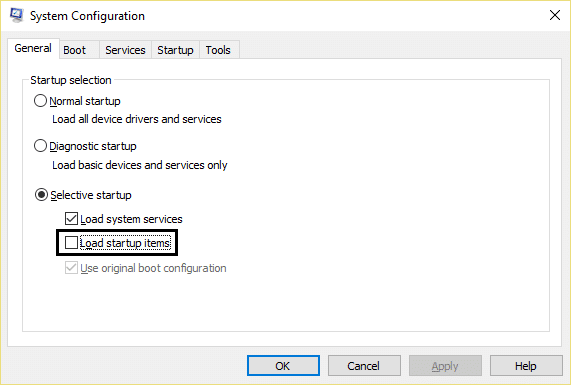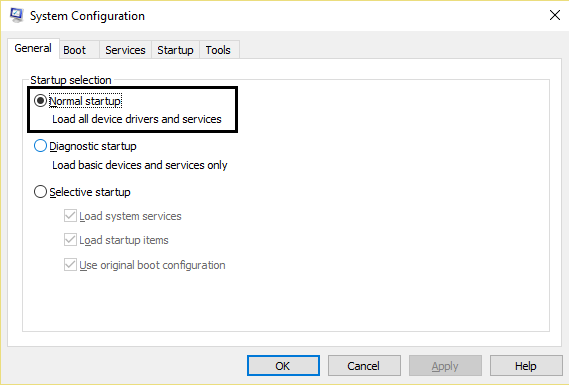How is Clean boot different than Safe mode?
A clean boot is different from safe mode and should not be confused with it. Safe mode shuts down everything required to launch Windows and runs with the most stable driver available. When you run your Windows in safe mode, non-essential processes do not start, and non-core components are disabled. So there are only a few things you could try in safe mode, as it is designed to run Windows in a stable environment as possible. Whereas on the other hand, Clean boot does not care about the Windows Environment, and it only removes the 3rd party vendor add-ons that are loaded on startup. All the Microsoft services are running, and all the components of Windows are enabled. A clean boot is mainly used to troubleshoot the software compatibility issue. Now that we have discussed Clean boot, let’s see how to perform it.
How is Clean boot different than Safe mode? Perform Clean Boot in Windows 10 Step 1: Load a Selective Startup Step 2: Enable half of the services Step 3: Determine whether the problem returns. Step 4: Enable half of the Startup items. Step 5: Determine whether the problem returns. Step 6: Resolve the problem. Step 7: Follow these steps to again boot to normal startup:
Perform Clean Boot in Windows 10
You can start Windows using a minimal set of drivers and startup programs by using “clean boot.” With the help of a clean boot, you can eliminate software conflicts.
Step 1: Load a Selective Startup
Press the Windows Key + R button, then type msconfig and click OK.
Under General tab under, make sure ‘Selective startup’ is checked.
Uncheck ‘Load startup items‘ under selective startup.
Select the Service tab and check the box ‘Hide all Microsoft services.’
Now click ‘Disable all to disable all the unnecessary services which might cause conflict.
On the Startup tab, click ‘Open Task Manager.’
Now, in the Startup tab (Inside Task Manager) disable all the startup items which are enabled.
Click OK and then Restart. This was only the first step involved to Perform Clean boot in Windows 10, follow the next step to continue to troubleshoot software compatibility issue in Windows.
Step 2: Enable half of the services
Press the Windows Key + R button, then type ‘msconfig’ and click OK.
Select the Service tab and check the box ‘Hide all Microsoft services.’
Now select half of the checkboxes in the Service list and enable them.
Click OK and then Restart.
Step 3: Determine whether the problem returns.
If the problem still occurs, repeat step 1 and step 2. In step 2, only select half of the services that you originally selected in step 2. If the problem does not occur, repeat step 1 and step 2. In step 2, only select half of the services that you didn’t select in step 2. Repeat these steps until you have selected all the checkboxes. If only one service is selected in the Service list and you still experience the problem, then the selected service is causing the problem. Go to step 6. If no service causes this problem, then go to step 4.
Step 4: Enable half of the Startup items.
If no startup item causes this problem, then Microsoft services are most likely to cause the problem. To determine which Microsoft service repeat steps 1 and 2 without hiding all Microsoft services in either step.
Step 5: Determine whether the problem returns.
If the problem still occurs, repeat step 1 and step 4. In step 4, only select half of the services you originally selected in the Startup Item list. If the problem does not occur, repeat step 1 and step 4. In step 4, only select half of the services you didn’t select in the Startup Item list. Repeat these steps until you have selected all the checkboxes. If only one startup item is selected in the Startup Item list and you still experience the problem, then the selected start item is causing the problem. Go to step 6. If no startup item causes this problem, then Microsoft services are most likely to cause the problem. To determine which Microsoft service repeat steps 1 and 2 without hiding all Microsoft services in either step.
Step 6: Resolve the problem.
Now you may have determined which startup item or service is causing the problem, contact the program manufacturer or go their forum and determine whether the problem can be resolved. Or you can run the System Configuration utility and disable that service or startup item or better if you can uninstall them.
Step 7: Follow these steps to again boot to normal startup:
Press the Windows key + R button and type ‘msconfig’ and click OK.
On the General tab, select the Normal Startup option and then click OK.
When you are prompted to restart the computer, click Restart. These are all the steps involved to Perform Clean boot in Windows 10. Recommended:
Windows Explorer has stopped working [SOLVED] Fix Restore Point Not Working in Windows 10 How to Turn Off DEP (Data Execution Prevention) Fix File System Errors with Check Disk Utility(CHKDSK)
That’s it you have successfully learned How to Perform Clean boot in Windows 10, but if you still have any queries regarding this guide, then please feel free to ask them in the comment’s section.










